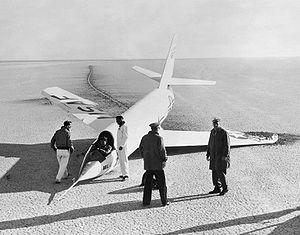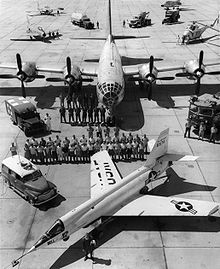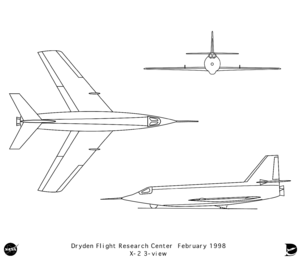Bell X-2 Video - "Starbuster" Newsreel
|
|

Picture - Bell X-2 #2 with a collapsed nose landing gear, after landing on the first glide flight, on 22 April 1952 at Edwards Air Force Base.
Role: Research aircraft
National origin: United States
Manufacturer: Bell Aircraft
First flight: 18 November 1955 (first powered flight)
Retired: 27 September 1956
Primary users: United States Air Force
National Advisory Committee for Aeronautics
Number built: 2
The Bell X-2 "Starbuster" was a research aircraft built to investigate flight characteristics in the Mach 2-3 range.
Design and development
Providing adequate stability and control for aircraft flying at high supersonic speeds was only one of the major difficulties facing flight researchers as they approached Mach 3. For, at speeds in that region, they knew they would also begin to encounter a "thermal barrier", severe heating effects caused by aerodynamic friction. Constructed of stainless steel and a copper-nickel alloy, and powered by a two-chamber XLR25 2,500 to 15,000 lbf (11 to 67 kN) sea level thrust throttleable rocket engine, the swept-wing Bell X-2 was designed to probe this region.
Operational history
Following launch from a modified B-50 bomber, Bell test pilot Jean "Skip" Ziegler completed the first unpowered glide flight of an X-2 at Edwards Air Force Base on 27 June 1952. Ziegler and aircraft #2 (46-675) were subsequently lost on 12 May 1953, in an inflight explosion during a captive flight intended to check the aircraft's liquid oxygen system.

Picture - X-2, crew, and support equipment
Lt. Col. Frank K. "Pete" Everest completed the first powered flight in the #1 airplane (46-674) on 18 November 1955. By the time of his ninth and final flight in late July 1956, he had established a new speed record of Mach 2.87 (1,900 mph, 3050 km/h). The X-2 was living up to its promise, but not without difficulties. At high speeds, Everest reported its flight controls were only marginally effective. High speed center of pressure shifts along with fin aeroelasticity were major factors. Moreover, simulation and wind tunnel studies, combined with data from his flights, suggested the airplane would encounter very severe stability problems as it approached Mach 3.
A pair of young test pilots, Captains Iven C. Kincheloe and Milburn G. "Mel" Apt, were assigned the job of further expanding the envelope and, on 7 September 1956, Kincheloe became the first pilot ever to climb above 100,000 ft (30,500 m) as he flew the X-2 to a peak altitude of 126,200 ft (38,466 m). Just 20 days later, on the morning of 27 September, Apt was launched from the B-50 for his first flight in a rocket airplane. He had been instructed to follow the "optimum maximum energy flight path" and to avoid any rapid control movements beyond Mach 2.7. Flying an extraordinarily precise profile, he became the first man to exceed Mach 3, reaching Mach 3.2 (2,094 mph, 3,370 km/h) at 65,500 ft (19,960 m). The flight had been flawless to this point, but, for some reason, shortly after attaining top speed, Apt attempted a banking turn while the airplane was still well above Mach 3 (lagging instrumentation may have indicated he was flying at a slower speed or perhaps he feared he was straying too far from the safety of his landing site on Rogers Dry Lake). The X-2 tumbled violently out of control and he found himself struggling with the same problem of "inertia coupling" which had overtaken Chuck Yeager in the X-1A nearly three years before. Yeager, although exposed to much higher vehicle inertial forces, as a result of extensive experience flying the X-1 was very familiar with its character, was able to recover. Unlike Yeager, Apt was unable to recover and both he and the aircraft were lost.
While the X-2 had delivered valuable research data on high-speed aerodynamic heat build-up and extreme high-altitude flight conditions, this tragic event terminated the program before the National Advisory Committee for Aeronautics could commence detailed flight research with the airplane, and the search for answers to many of the riddles of high-Mach flight had to be postponed until the arrival, three years later, of the most advanced of all the experimental rocket planes, the North American X-15.
Flight test program
Two aircraft completed a total of 20 flights (27 June 1952 - 27 September 1956).
46-674: seven glide flights, 10 powered flights, crashed 27 September 1956
46-675: three glide flights, destroyed 12 May 1953

Specifications
Data from
General characteristics
Crew: one, pilot
Length: 37 ft 10 in (11.5 m)
Wingspan: 32 ft 3 in (9.8 m)
Height: 11 ft 10 in (3.6 m)
Wing area: 260 ft² (24.2 m²)
Airfoil: 2S-50 bicon
Empty weight: 12,375 lb (5,600 kg)
Loaded weight: 24,910 lb (11,300 kg)
Max takeoff weight: 24,910 lb (11,300 kg)
Powerplant: 1x— Curtiss-Wright XLR25 rocket engine, 15,000 lbf (67 kN)at sea level
Performance
Maximum speed: Mach 3.196 (2,094 mph, 3,370 km/h)
Service ceiling: 126,200 ft (38,466 m)
Popular culture
The 1956 film Toward the Unknown starred the X-2, William Holden, Lloyd Nolan and Virginia Leith. A brainwashed former POW tries to return to test flying; co-starring the Martin XB-51 and the Edwards AFB flight line. In the pilot episode of Quantum Leap, Sam Beckett (played by Scott Bakula) leaps into the body of fictional test pilot Tom Stratton in 1956, during which time he exceeds Mach 3 in the Bell X-2. At the beginning of the 2000 film Space Cowboys, Frank Corvin (Clint Eastwood) and pilot William "Hawk" Hawkins (Tommy Lee Jones) crash a fictional two-seat version of the X-2.
Mach number
Comparable aircraft
Douglas D-558
Bibliography
Hallion, Dr. Richard P. "Saga of the Rocket Ships." AirEnthusiast Five, November 1977-February 1978. Bromley, Kent, UK: Pilot Press Ltd., 1977.
Matthews, Henry. The Saga of the Bell X-2, First of the Spaceships . Beirut, Lebanon: HPM Publications, 1999. No ISBN
Winchester, Jim. "Bell X-2." Concept Aircraft: Prototypes, X-Planes and Experimental Aircraft. Kent, UK: Grange Books plc, 2005. ISBN 1-84013-309-2.
Living Warbirds: The best warbirds DVD series.
Source: WikiPedia